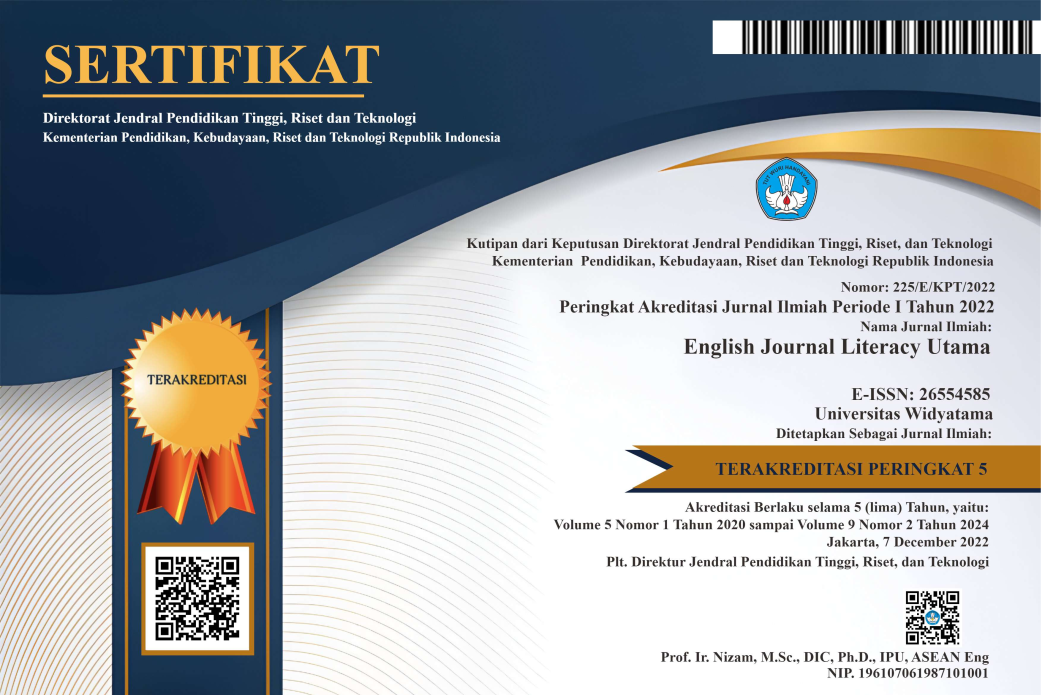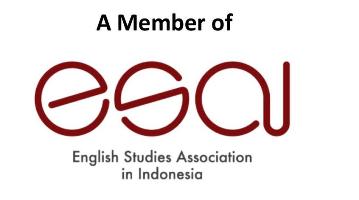The Effect Of Peer Feedbacks On Students' Speech
DOI:
https://doi.org/10.33197/ejlutama.v7i1.183Kata Kunci:
Peer feedback, Students' speechAbstrak
In speaking English, students still find many difficulties especially when students make speeches, and unfortunately in giving speeches students are rarely given feedback so they don't know where their mistakes are. Feedback can be given by teachers or their peer. In fact, transactional peer feedback is believed to be able to foster students’ participation as well as communicative competence in compared with the feedback from the teacher (Liu & Carless, 2006). In this paper, the researcher intends to find out how peer feedback is implemented, the focus especially discusses the types of feedback used by the participants in this study, and the effect of conducting peer feedback on students' speech. This study makes use of descriptive qualitative method. Involving 6 participants. The data sources of this research are observations, student speech scores, and interviews. Observations were conducted in 3 weeks, the students' speech scores from the assessments of their peers before and after peer feedback, and interviews. From the observation, the researchers identified the types of feedback that were often used by participants, namely corrective feedback, reinforcing feedback, and didactic feedback. From the interview, the researcher perceived that the students found it beneficial from given feedback. In addition, peer-feedback techniques also have a positive effect on participants. Peer feedback can improve student speech, student confidence, and fun learning activities. Even though it was revealed that peer feedback has a lot of benefits, but most of participants agree that peer feedback activities should be followed by feedback from the teacher. Because they believe the feedback from their teacher is more reliable.
Referensi
Astuti, N. K. (2011). Jurus kilat jago: public speaking.!?: secara otodidak. Laskar Aksara. https://books.google.co.id/books?id=-YLajgEACAAJ
Brown, H. D. (2004). Language assessment: Principles and classroom practice. Pearson Education, Inc.
Cambridge Press, U. (2008). Cambridge Advanced Learners Dictionary. Cambridge: Cambridge University Press.
Demirbilek, M. (2015). Social media and peer feedback: What do students really think about using Wiki and Facebook as platforms for peer feedback? Active Learning in Higher Education, 16(3), 211–224. https://doi.org/10.1177/1469787415589530
DiGiovanni, E., & Nagaswami, G. (2001). Online peer review: An alternative to face-to-face? ELT Journal, 55(3), 263–272. https://doi.org/10.1093/elt/55.3.263
Fraenkel, J. R. (2009). How to Design and Evaluate Research in Education. New York. McGrew-Hill Companies.
Ghasani, & Sofwan. (2017). Appraisal And Speech Structure Of Contestants’ Speeches In Speech Contest Of ESA WEEK Competition. English Education Journal, 7(2).
Gielen, Peeters, Dochy, Onghena, & Struyven. (2010). Improving the effectiveness of peer feedback for learning. Lerning and Instruction, 20(4).
Harmer. (1998). How to Teach English. Longman.
Hattie, & Timperley. (2007). The power of feedback. Review of Educational Research.
Kerr. (2017). Giving feedback on speaking. Cambridge Papers on ELT Series. http://www.cambridge.org/elt/blog/wp-content/uploads/2018/02/Cambridge-Press_Whitepaper_Feedback_Speaking_2018.pdf
Liu, & Carless. (2006). Peer Feedback: the learning elemet of peer assessment. Teaching in Higher Education, 11(3). https://doi.org/https://doi.org/10.1080/13562510600680582
Mamoon-Al-Bashir, Md., Kabir Rezaul, Md., Rahman, I. (2016). The Value and Effectiveness of Feedback in Improving Students’ Learning and Professionalizing Teaching in Higher Education. Journal of Education and Practice, 7(16), 38.
Mulgrave. (2004). Speech: A Handbook of Voice Training Diction and Public Speaking.
Oktavian. (2013). An Analysis of Corrective Feedback in Students’ Speaking Activity at Senior High School. University of Muhammadiyah, Gresik.
Sellnow. (2005). Confident Public Speaking 2nd Edition.
Situmorang, R. N. (2016). The Effect of Public Speaking by using Manuscript Speech on Students’ Speaking Achievement of Twelveth grade at SMA N 11 Medan. Repository UHN.
Slagell, A. (2009). Public Speaking. 21st Century Communication: A Reference Handbook. Notes and Queries, s8-III(64), 218.
Steele, J. (2010). The Definition of Public Speaking. Www.Speechmastery.Com. https://www.speechmastery.com/definition-of-public-speaking.html
Sukini, I. (2008). NoSD/MI, Bahasa Indonesia untuk kelas 6 Title. Jakarta: Bookkeeping Center of the Ministry of National Education.
Tuzi, F. (2004). The impact of e-feedback on the revisions of L2 writers in an academic writing course. Computers and Composition, 21(2), 217–235. https://doi.org/10.1016/j.compcom.2004.02.003
van der Pol, J., van den Berg, B. A. M., Admiraal, W. F., & Simons, P. R. J. (2008). The nature, reception, and use of online peer feedback in higher education. Computers and Education, 51(4), 1804–1817. https://doi.org/10.1016/j.compedu.2008.06.001
Warschauer, M., & Ware, P. (2006). Automated writing evaluation: Defining the classroom research agenda. Language Teaching Research, 10(2), 157–180. https://doi.org/10.1191/1362168806lr190oa
Unduhan
Diterbitkan
Terbitan
Bagian
Lisensi
Hak Cipta (c) 2022 Susie Kusumayanthi, Inti Lestari

Artikel ini berlisensiCreative Commons Attribution-NonCommercial-ShareAlike 4.0 International License.
Creative Commons Attribution-ShareAlike 4.0 International License















